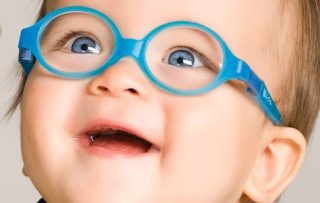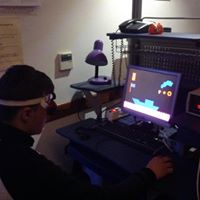DEPARTMENT
AMBLYOPIA
Amblyopia or “lazy eye” – is the loss or lack of development of central vision in one eye that is unrelated to any eye health problem and is not correctable with lenses. It can result from a failure to use both eyes together. Lazy eye is often associated with crossed-eyes or a large difference in the degree of nearsightedness or farsightedness between the two eyes. It usually develops before the age of 6, and it does not affect side vision.
Symptoms may include noticeably favoring one eye or a tendency to bump into objects on one side. Symptoms are not always obvious.


Treatment for lazy eye may include a combination of prescription lenses, prisms, vision therapy and eye patching. Vision therapy teaches the two eyes how to work together, which helps prevent lazy eye from reoccurring.
Early diagnosis increases the chance for a complete recovery. This is one reason why all ophthalmologists recommends that children have a comprehensive optometric examination by the age of 6 months and again at age 3. Lazy eye will not go away on its own. If not diagnosed until the pre-teen, teen or adult years, treatment takes longer and is often less effective.
The term “amblyopia” is often used in literal translation from the Greek, “lazy eye” – because it laconically reflects the essence of the pathological mechanism. The eye, which for whatever reason can not fully perform its functions, takes on an ever lesser burden and, accordingly, loses value as the organ of vision. The central nervous system perceives such an eye as a hindrance and gradually excludes it from the process of creating a visual image.
In this case, gross organic lesions or damage in the poorly seeing (and therefore “lazy”) eye may not be, but vision progressively worsens, sensitivity to light, color and contrast decreases, and autofocusing-accommodation becomes less clear and quick. Develops amblyopia, as a rule, on one eye, although in some difficult cases, both eyes are “lazy” – and neither glasses, nor contact lenses, this state is no longer corrected. Special treatment is required, and here its decisive factor is its timeliness.
In childhood, amblyopia can develop due to the impossibility of forming a full binocular vision – for example, with strabismus or unequal parameters of refraction (refraction of light) in the right and left eyes. The time frame when ophthalmic care is effective is quite large: there are cases of successful treatment of amblyopia in mature and even old age. However, with each lost year, the duration and the necessary intensity of the therapeutic course increases, and the probability of a complete cure or cardinal improvement, respectively, decreases.
The causes of amblyopia
The most common causes of amblyopia include:
- strabismus in children up to 5-8 years;
- short-sightedness or hyperopia in a high degree;
- the lack of visual signals received by the eye.
Numerous risk factors have also been established, which to some extent provoke the development of amblyopia:
- premature birth and / or insufficient weight of the newborn;
- congenital anomalies or lesions of the retina;
- severe neurologic pathology;
- delays and scarcity of psychophysical development;
- genetic factor (heredity, burdened with any ophthalmologic diseases);
- smoking, drinking alcohol and treating some groups of medications during pregnancy also increases the statistical probability of fetal strabismus and amblyopia.
It was found that the incidence of disability due to complete blindness in amblyopia is significantly higher compared to a healthy population: this is mainly explained by the fact that in case of loss of vision on the healthy eye (for example, due to trauma or severe infection, which during life no one is immune), the amblyopic eye can no longer compensate for lost visual functions.
In addition, the presence of amblyopia sharply narrows the range of available professions and fields of activity: automatically and unconditionally excludes specialties (even if a person is professionally fit for them in other psychological and physiological characteristics), requiring a hundred percent stereoscopic vision, stable and flexible visual attention, good visual-motor coordination.
Symptoms
Typical amblyopia clinical picture includes the following complaints:
- fuzzy, “poor” vision on one, less often on both eyes;
- Difficult and distorted perception of perspective, depth of space, three-dimensional proportions of surrounding objects, distances to them;
- in childhood – tangible difficulties with learning and learning new material, especially if it requires a qualitative visual perception;
- in the presence of strabismus – an uncontrolled deflection of the squinting eye from the object to which the gaze is directed by effort of will, as well as doubling with a binocular view, disappearing if the mowing eye is covered.
It should be emphasized that amblyopia in childhood can seriously and sometimes irreversibly affect the overall development and learning processes of the child. According to statistical data, almost a third of these patients have visual impairment and learning problems, and the frequency and severity of such symptoms is significantly reduced with early ophthalmologic intervention and the appointment of optical correction before the age of 4 years.
Amblyopia of one eye usually does not have such a detrimental effect on the general state of the visual system, since a healthy (or relatively healthy) eye carries the main burden of forming a visual flow into the brain analytic zones.
Diagnostics
Early treatment for amblyopia involves, of course, timely diagnosis. Therefore, scheduled examinations by a pediatric ophthalmologist are necessary and mandatory. The first consultation, designed to exclude deprivational amblyopia (i.e., caused by a lack of visual stimuli), should be performed no later than 5-6 weeks of age; During the first year of life, the functional state and refractive characteristics of the visual system should be studied in detail. If the child falls into a risk group (for example, according to ophthalmic heredity), he is registered with regular, – at least once a year, – by control examinations.
BOOK ONLINE
Address
Qemal Stafa Str, Apt 31, 3-rd C Floor
Near the General Prosecutor’s Office
klinika.uzllova@yahoo.com
info@eye.al
Phone
0682074039
04 22 52 306


